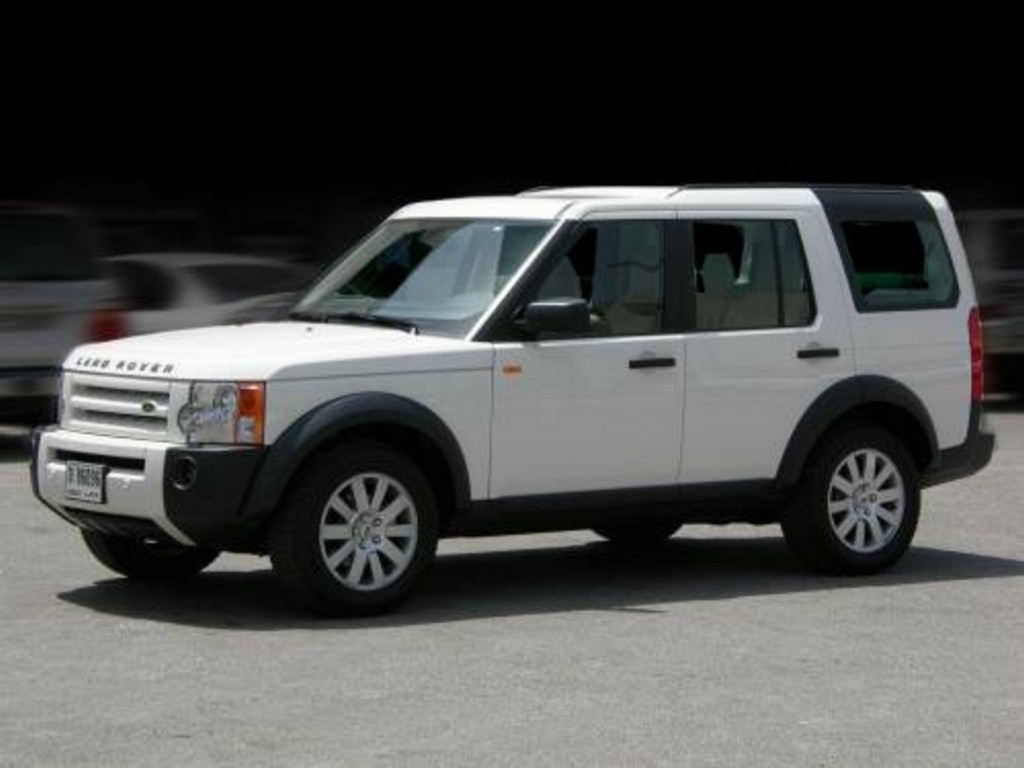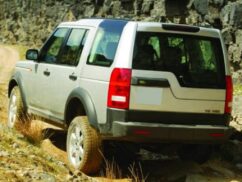2006 Land Rover LR3 V6

| The Good: – Good on-road ride quality – Abundant interior room – Excellent offroad abilities |
The Bad: – Slow acceleration – Controversial styling – Unimpressive fuel economy |
There was once a time when all 4WD vehicles were true off-roaders. They looked tough, sat high and laughed at mountains. Nowadays, there are so many 4WDs that chicken out at the sight of pebbles, it makes us wonder if someday all 4WDs will lose the abilities that made them so desirable. Bucking the trend is the Land Rover LR3, a replacement for the Discovery, and a true off-roader if there ever was one. We drove the V8 model some time back, and now we spend some time with the overshadowed V6 model, which is a new addition to the LR3 line-up.
The exterior design still provokes strong emotions in us, but we appreciate it more now, as we had more time for the unorthodox lines of the LR3 to settle in. There are large amounts of black plastic cladding, and it somehow offers a contrast to the painted metal without appearing overly garish. We believe there is an option to get the cladding painted though, which would immediately give the LR3 a more modern look.
The interior in our V6 tester is a combination of black and beige, and it looks much more pleasant than the all-black treatment in our previous LR3 test vehicle. Most of the touchable door surfaces are soft to the touch, and all materials are of a high quality, whether plastic or leather. Cabin space is abundant, with more front-and-back legroom than, say, an older GMC Yukon, and more headroom than, say, a bus. Space is perfectly managed inside, helped by the tall roof and upright windshield. The feeling of space is also enhanced by large glass windows, three glass panels in the roof and relatively thin pillars, all of which also help visibility. However, third-row passengers in this seven-seater are still going to complain about kneeroom. All the leather-trimmed seats look and feel great, with tall headrests and electric controls for the front ones. Seat-side bolstering is minimal, so fast cornering requires holding on to something. A notable omission is a missing rear-seat fold-down centre armrest commonly found in most cars, replaced instead by a proper seat. There are tons of cup-holders and storage areas in the doors, along with a few more in the centre console for front passengers, who also enjoy dual armrests. Slap down the third-row seating and the rear luggage area expands to fit a bedroom’s worth of furnishings.
There is a good amount of electronic componentry in the V6-powered LR3, losing nothing against the V8 model. Our tester has an excellent CD stereo, with big speakers integrated into every door, along with individual headphone inputs for the rear seats, including the third row. Our model did not have the optional rear-seat DVD system, but it did have a simple touchscreen navigation system, also used as a vehicle data monitor. It is complicated to use because it requires going through various menus to get to simple options, like cancelling destinations, but it is easier to input destinations thanks to the on-screen alphabet keypad. Other positive interior features include a very strong air-conditioning system, with vents both front and rear, that is good enough to cool down this massive vehicle. Standard features include the requisite power windows, mirrors, keyless entry and cruise control.
The V6 mill powering this big machine is a 215 hp 4.0-litre unit, good for 360 Nm of torque. These numbers are hardly impressive, but the engine proved to have enough useful muscle to move this heavyweight with authority on city streets. Taking off from stoplights was fun with the help of torquey low-rpm response, but keep the pedal floored, and the V6 loses steam at higher revs, taking as long as 11 seconds to hit 100 kph from standstill. It does reach this speed with utmost smoothness, emanating an exhaust note that is a cross between a V8 and a vacuum cleaner. The six-speed automatic gearbox seems to be a smoother operator than the one in the V8 model, specifically when downshifting, but we don’t really know why. Interestingly, the V6 has roughly the same high fuel consumption numbers as the V8, so the only real benefit of this V6 engine is the lower starting price. The large 82-litre fuel tank helps long-range cruising immensely though.
Once up to speed on the highway, the LR3 is a comfortable cruiser. It is very quiet, except for some noticeable wind noise that starts singing from 100 kph. The ride is slightly floating over uneven highway surfaces, but stability at speed is not compromised. Our tester was equipped with the optional air suspension system, which probably kept the high-speed cruise more civilised. There were some blind spots though, even with the big windows and mirrors. The mirrors fail to cover the sides of the vehicle just behind the driver, solved by annoying shoulder checks, but the central rear-view is useless with a full load of passengers in the vehicle. This is not a problem while parking however, as parking sensors detect objects around the bumpers, but the big LR3 sure does fill up a parking space, but the light steering aids in one-handed parking manoeuvres.
Hit the curves with the LR3, and you’ll realise that you are a moron, but the Land Rover seems to know it. Our air-suspended LR3 attempts to kill body roll as much as possible, but it is obviously tuned for comfort, so there is still some lean. However, body roll is much less than a typical 4WD with standard suspension, and we found the tall LR3 to be more agile than smaller vehicles like the Nissan Pathfinder and the GMC Envoy. There is a fair amount of grip from the 18-inch wheels shod in 255/60 tyres, and it has none of the characteristic tyre-whine that many 4WDs suffer from as they start to lose grip in a tight corner. And the four-wheel disc brakes are fairly good, helped by anti-lock brakes, electronic stability control and other such electronic doodads. The LR3 can be lowered with a knob on the centre console to ease climbing in and out of this wagon, but when we tried to keep the LR3 suspension setting permanently low, to improve handling, it just automatically pops back up to the standard medium-height setting again.
The same knob can be used to raise the height of the LR3 too, for better ground clearance off the road. With a full set of suspension options to fine-tune for different types of terrain, along with available low-range gearing at the flick of a little lever, the LR3 is ready for anything. Keeping this machine from getting stuck on the way to the peak of a steep dune requires keeping the power on constantly, with the engine strung to its limits. It was the only way to beat the miniscule muscle of the V6 from embarrassing us, but once over the peak and going down the slope, the LR3 took over with the help of a Hill Descent Control feature at the press of a button, which braked for us as we rolled down. Smaller sand dunes and little rocks were hardly a challenge.
The V6-powered Land Rover LR3 may be somewhat lethargic on the road when the pedal is floored, but it gives up nothing in the way of off-road capability on the dunes. A relatively reasonable base price allows easy access to Land Rover heritage for well-heeled people, and optioning it out fully with entertainment features allows it to be as satisfying as the Range Rover in terms of play value. Fuel economy concerns aside, anyone could learn to love this vehicle for what it can do rather than what it can’t. It can’t chase a Ferrari, but it can run one over any day.












There are no comments. Be the first!